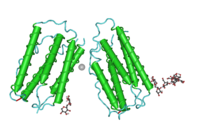
Photo from wikipedia
Epithelial-Mesenchymal Transition (EMT) and immunoevasion through upregulation of Programmed Death-Ligand 1 (PD-L1) are important drivers of cancer progression. While EMT has been proposed to facilitate PD-L1-mediated immunosuppression, the molecular mechanisms… Click to show full abstract
Epithelial-Mesenchymal Transition (EMT) and immunoevasion through upregulation of Programmed Death-Ligand 1 (PD-L1) are important drivers of cancer progression. While EMT has been proposed to facilitate PD-L1-mediated immunosuppression, the molecular mechanisms of their interaction remain obscure. Here we provide insight into these mechanisms by proposing a mathematical model that describes the crosstalk between EMT and Interferon gamma (IFNγ)-induced PD-L1 expression. Our model shows that via interaction with microRNA-200 (miR-200), the multistability of the EMT regulatory circuit is mirrored in the PD-L1 levels, which are further amplified by IFNγ stimulation. This IFNγ-mediated effect is most prominent for cells in a fully mesenchymal state, and less strong for those in an epithelial or partially mesenchymal state. Additionally, bi-directional crosstalk between miR-200 and PD-L1 implies that IFNγ stimulation allows cells to undergo EMT for lower amounts of inducing signal, and that IFNγ presence accelerates EMT and decelerates Mesenchymal-Epithelial Transition (MET). Overall, our model agrees with published findings and provides insight into possible mechanisms behind EMT-mediated immune-evasion; and primary, adaptive, or acquired resistance to immunotherapy. Our model can be used as a starting point to explore additional crosstalk mechanisms, as an improved understanding of these mechanisms is indispensable for developing better diagnostic and therapeutic options for cancer patients. Graphical Abstract Schematic overview of the crosstalk between Epithelial-Mesenchymal Transition (EMT) and Interferon gamma (IFNγ)-induced Programmed Death-Ligand 1 (PD-L1) expression. IFNγ-induced PD-L1 expression promotes the occurrence of EMT. EMT, also induced by, for example, Transforming Growth Factor Beta (TGFβ), increases PD-L1 expression levels, facilitating tumor immunoevasion.
Journal Title: Royal Society Open Science
Year Published: 2022
Link to full text (if available)
Share on Social Media: Sign Up to like & get
recommendations!